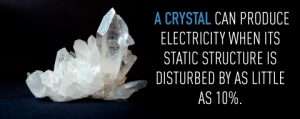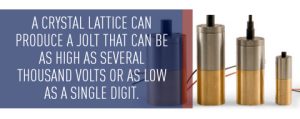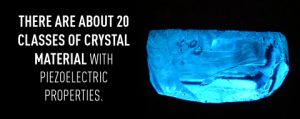Jump To: How It Works | Direct Piezo Effect | Converse Piezo Effect | Material Characteristics

Anyone not familiar with it might immediately ask: What is the piezoelectric effect? It describes the various processes of electricity generation using a piezoelectric material.
Technically, the piezoelectric effect is described as the linear electromechanical interaction between the mechanical and electrical state in crystalline materials that have no inversion symmetry.
APC International fields many questions about piezoelectric technology and gladly shares information about custom solutions and standards for all kinds of projects from cylinders and discs to nebulizers and actuators. The origin of piezoelectricity dates back more than a century, but the rapid advancement and expansion of its technology is more recent. New solutions come into supply as quickly as demand, and innovation abounds in an environment where everybody wants everything to be faster, easier and more efficient.
Two French-physicist brothers, Pierre and Jacques Curie, discovered piezoelectricity in 1880 when they realized that applying pressure to certain types of crystals produces an electric charge. The word the French brothers picked for the phenomenon comes from the Greek words piezo, which means to push, and piezein, which means to squeeze.
The piezoelectric effect is the general term used for all the technology under the piezoelectric umbrella, most of which was not developed until the 20th Century. There are direct and converse piezoelectric methods, many piezoelectric materials and a nearly endless number of applications for piezoelectric technology.
The piezoelectric effect works into the past, present and future with a history of developments during World Wars I and II. In the first, piezoelectric played an instrumental part in the first underwater submarine-detection systems. Developments continued through the second war, often in secrecy with private companies and no communication among the teams.
In 1951, the Japanese formed a piezoelectric cooperative that leaped forward in technical and manufacturing concepts. They developed patent-free concepts and then products that served quickly growing needs at the right time. For one example, the piezoelectric signal filter addressed a rapidly rising need in the industries of TV, radio and communication equipment.
Such items as audio buzzers in smoke alarms and tone generators and technology within TV remote controls, as well as many other products, helped grow the presence of piezoelectricity in America from tiny and practically invisible to large and notable.
Even as much as the Japanese accomplished with the technology, there was still much more room for further growth, discovery and invention. By 1980, piezoelectric technology had begun to permeate industry more and more often as it was used to develop solutions, spurred by the constant efforts to expand, refine and study it.
You will also see piezoelectric expressed as lead zirconate titanate and abbreviated as PZT. Both refer to the piezoelectric effect, which is the type of electricity the Curie brothers discovered, along with all its variations and advancements. The technology has evolved since then and permeated our society in places people may not realize or expect.
For examples, smart phones, video games, digital butlers and other devices that have voice-recognition software contain piezoelectric technology. A crystal transforms your voice energy into electrical signals, which a phone or computer then senses and interprets.
Your keyless-entry devices for the home or vehicle work with piezoelectric technology, too. It is within many kinds of health-patient monitors, fish and depth finders, audible alarms and airbag sensors.
One of the latest developments is with tennis rackets of professional and other high-level tennis players. A piezoelectric chip is part of a system within the rackets that helps offset the amount of shock and vibration that typically transfer to a player’s arm. Traditional rackets are known for being stiff and unyielding, and the piezoelectric effect provided a solution.
These and other examples like them hold part of the answer to the question: What is the piezo effect? Delving deeper leads to more questions and answers.
Webster’s Dictionary defines piezoelectricity as “electricity or electric polarity due to pressure especially in a crystalline substance such as quartz.” The effect is the potential to generate voltage, and it occurs when pressure is applied to a crystal or other kind of material with piezoelectric properties.
The nature of this ability relates to the electricity dipole moments of solid materials, as well as the molecular structure, density and polarization of the piezoelectric material. A whole sector of science revolves around the research and development of piezoelectric technology based upon the various materials’ orientation, symmetry and reaction to several types of mechanical stress.
The pressure applied to produce the piezoelectric effect may be a squeeze, knock, tap or other action that disturbs but does not fracture the material. Electronically programmed metal plates commonly do the job of exerting the precise amount of pressure needed to generate piezoelectric power.
The charge occurs when the crystal lattice of the object, its charge balance, is disturbed slightly. For example, a crystal can produce electricity when its static structure is disturbed by as little as 10 percent. When there is no stress on a piezoelectric material, its positive and negative ions sit balanced and do not react. Down to its core elements, piezoelectricity results from a methodical process of disturbing the atoms within compatible materials.

Piezoelectric crystals act like batteries because they have a positive charge on one face and a negative charge on the opposing face. As with most technologies over time, piezoelectric options and usages have expanded, and the technology has been refined. There are many naturally occurring and man-made piezoelectric materials in broad use.
It would be impossible to describe all the potential uses of piezoelectric technology and how they work, but a few examples help demystify the piezoelectric effect.
Many kinds of sensors use piezoelectric components, but applications involving sound are probably most typical. Microphones and the pickup mechanism in an amplified, electric guitar often use piezoelectric sensors. The ultrasonic transducers used for nondestructive testing and medical imaging, which use high-frequency sound, contain piezoelectric sensors almost exclusively.
For another example, many types of motors use piezoelectric crystals because they can be manipulated with micro-precision and create accurate, reliable motion. An electrical pulse hits the piezoelectric element and applies pressure to an opposing plate, which then moves in the desired direction.
Some gas appliances and many electric lighters use piezoelectric mechanisms. With the lighter, a user presses a button, which trips a spring-loaded hammer to hit the element and produce enough voltage that the current flows across a spark gap to heat and light the gas. Applications such as a gas stove or water heater would employ automatic piezoelectric-injection systems that work the same way.
The direct piezoelectric effect happens as a result of direct stress to the material. It occurs when pressure, typically using two metal plates, is applied to a piece of piezoelectric material such as a crystal or ceramic. The metal plates clamp the piezoelectric material and collect the charge as it is generated.
As a crystal lattice is disturbed by pressure or other stress, a difference results from the charge imbalance. It can produce a jolt that can be as high as several thousand volts or as low as a single digit.

As mechanical pressure is placed on the piezoelectric material, its positive and negative charge centers shift, which creates an external electric field. This process is the direct piezoelectric effect.
The year after the Curie brothers discovered the piezoelectric effect, Gabriel Lippman found the converse piezoelectric effect. The Curie brothers later experimented with Lippman’s discovery and confirmed it. Together the three scientists had proven the linear and reversible nature of piezoelectricity.
The principle states that when an electric field is applied to the crystal lead or other piezoelectric materials, it slightly deforms or disorders them. In other words, an electrical current compels the atoms in the material to vibrate back and forth, and that process is called the converse (sometimes inverse) piezoelectric effect. The piezoelectric effect is reversed by applying an electrical voltage to shrink the crystal, and the converse piezoelectric effect then converts electrical energy into mechanical energy.
The converse piezo effect helps in the development of equipment that produces acoustic sound waves, such as speakers and buzzers. The technology provides an ultra-thin profile that is suitable for technologies such as phones, medical ultrasound and sonar transducers, as well as motors and actuators.
All piezoelectric materials are non-conductive and can be classified into one of two categories: Crystal or ceramic. They are technically known as materials with the potential to produce electricity when mechanical pressure is applied to them to disturb the inner charge or when they’re subjected to electricity externally to produce an inner charge.
Piezoelectric properties are noted in many kinds of naturally occurring materials:
There are about 20 classes of crystal material with piezoelectric properties. The term “crystal” in some cases elicits images of the shimmering, multicolored rocks found in a souvenir shop when in actuality, many types of materials may be considered a crystal. The scientific definition of it is any solid materials with atoms or molecules arranged in an orderly way and based on infinite repetitions of the same building block or unit cell.

Other characteristics of piezoelectric materials tell a part of their chemical-property story. Their atomic structure is not symmetrical, and they’re electrically neutral with a positive and negative charge that cancel each other and sit in perfect balance until disturbed.
While plenty of natural materials are still used now, it is much more common in today’s society for manmade materials, including crystals and ceramics, to produce the piezoelectric effect. Piezoelectric ceramic materials are ionically bonded and contain positive and negative charges. When stress is applied, the ions within the material move, resulting in an electric dipole or polarization.
Barium titanate and lithium niobate are some of the synthetic materials that have proven to hold more capacity for electricity generation than most natural materials. Scientists generally create PZT using lead, zirconium, high temperatures and the chemical compound titanate, though it is worth noting there are many efforts underway to produce lead-free piezoelectric technology.
The materials are used in such items as ultrasound transducers, ceramic capacitors, sensors and actuators. Barium titanate is a ferroelectric ceramic material that contains piezoelectric properties, and only crystals have been used longer. Lithium niobate is a similar ferroelectric ceramic that has piezoelectric properties and is made from a compound that includes oxygen, lithium and niobium.
Piezoelectric technology can be both an independently operating device or a part of a device. Both ways considered, the piezo effect applies to a nearly endless list of products, many of them workhorses of industry:
Piezoelectric actuators, for example, might be found in Braille or knitting machines, cell phones and video cameras because they work well for an ultra-precise, auto-focus mechanism. Alarm clocks and similar devices that emit simple, quality sounds commonly contain piezoelectric speakers. Piezo drivers have the ability to convert low-voltage energy into higher-voltage power for piezoelectric devices.
The converse piezoelectric effect is often used to produce a spark to light appliances such as the grill, room heaters and the pilot light on hot-water heaters. Clocks frequently use the direct piezoelectricity of natural crystals since they have frequencies conducive to keeping precise time. Computers, for example, usually use a quartz clock to organize data.
In microphones and record players, piezoelectric crystals are usually the mechanism that catches the sound energy and delivers it to the component that translates the signals and produces the sound we hear and understand. Piezoelectric technology drives the inkjet heads in many kinds of printers, and there are all sorts of patents pending to improve upon current technology.
Other possible developments in the future of piezoelectric technology include a wearable heart-rate monitor, toe heaters to prevent frostbite and converters to harness the energy of ocean waves.

APC International offers a wealth of piezoelectric expertise acquired throughout decades of working with the technology. We focus on client service and relationships with such things as a free estimate and experienced consultants who listen and share knowledge.
We make things that are standalone products as well as a variety of product components. We design and implement solutions for many kinds of businesses across many industries. Our acronym refers to the days when APC was known as the American Piezo Ceramic company.
Our scientists and engineers develop precision, piezoelectric solutions using ceramic technology, and the solutions occupy a significant range. For examples, APC International provides clients all around the world with design, machine, press, fire and custom-electrode services. We participate in the long-term solution with questions, customization and periodic updates.
We have the capacity to walk with clients from the first stage, when they realize a solution or improvement is needed, until well past the point when they have implemented it and begun to benefit from it. Don’t hesitate to let us know how we can help you use the piezo effect to create benefits for your business.
Top Uses of Piezoelectricity in Everyday Applications
Piezo Buzzers vs. Magnetic Buzzers
Principles of Piezoelectric Energy Harvesting